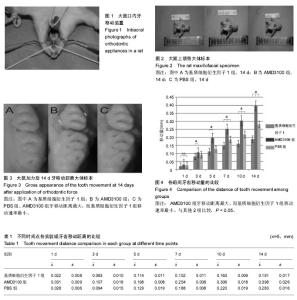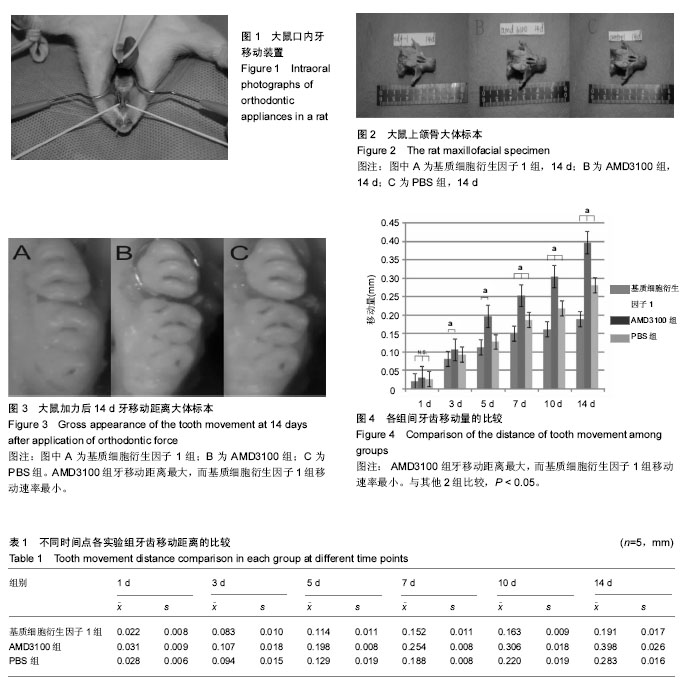| [1] Kanzaki H, Chiba M, Arai K,et al.Local RANKL gene transfer to the periodontal tissueaccelerates orthodontic tooth movement.Gene Therapy.2006;13:678-685.[2] Takano-Yamamoto T, Kawakami M, Kobayashi Y, et al.The Effect of Local Application of 1,25-Dihydroxycholecalciferolon Osteoclast Numbers in Orthodontically Treated Rats. J Dent Res.1992;71(1):53-59. [3] Kawakami M, Takano-Yamamoto T. Local injection of 1,25-dihydroxyvitamin D3 enhanced bone formationfor tooth stabilization after experimental tooth movement in rats. J Bone Miner Metab.2004;22:541-5462.[4] Kale S, Kocadereli I, Atilla P, et al.Comparison of the effects of 1,25dihydroxycholecalciferol and prostaglandin E2on orthodontic tooth movement. Am J Orthod Dentofacial Orthop. 2004;125:607-614.[5] Leiker BJ, Nanda RS, Currier GF, et al. The effects of exogenous prostaglandins on orthodontic tooth movement in rats. Am J Orthod Dentofac Orthop.1995;108: 380-388.[6] Liu ZJ, King GJ, Gu GM, et al.Does Human Relaxin Accelerate Orthodontic Tooth Movement in Rats. AnnNY Acad Sci.2005;1041:388-394.[7] 侯艳蓉,梁傥,罗财成,等. 白细胞介素1加速兔牙齿移动的实验研究[J].中华口腔医学杂志,1997, 32(1):46-48. [8] Kohno S, Kaku M, Tsutsui K, et al. Expression of vascular endothelial growth factor and effects on bone remodeling during experimental tooth movement. J Dent Res. 2003;82(3): 177-182.[9] 刘侃,沈刚,刘泓虎,等. 中草药灯盏花加速豚鼠牙移动的实验研究[J].口腔医学, 1992,12(1):17-19. [10] 王磊,张梅,王旭霞,等. 中药川续断促进再生牙周对正畸力反应的研究[J].山东大学学报(医学版),2011,(49)11:18-20.[11] Zhu W, Liang G, Huang Z,et al. Conditional inactivation of cxcr4 in osteoprecursors reduces postnatal bone formation due to impaired osteoblast development. J Biol Chem. 2011; 286(30):26794-26805.[12] Hirbe AC, Rubin J, Uluçkan O, et al. Disruption of CXCR4 enhances osteoclastogenesisand tumor growth in bone. PNAS.2007;104(35): 14062-14067. [13] Lee W, Karapetyan G, Moats R, et al. Corticotomy-/ osteotomy-assisted tooth movement microCTsdiffer. J Dent Res.2008;87(9):861-867.[14] Liem AM, Hoogeveen EJ, Jansma J, et al. Surgically facilitated experimental movement of teeth: systematic review. Br J Oral Maxillofac Surg.2015;53(6):491-506.[15] Frost HM. The regional acceleratory phenomenon:a review. Henry Ford Hosp Med J.1983;31(1): 3-9.[16] Schilling T, Müller M, Minne HW, et al. Influence of inflammation?mediated osteopenia on the regional acceleratory phenomenon and the systemic acceleratory phenomenon during healing of a bone defect in the rat. Calcif Tissue Int.1998;63(2):160-166.[17] Alikhani M, Raptis M, Zoldan B, et al. Effect of micro-osteoperforations on the rate of tooth movement. Am J Orthod Dentofacial Orthop.2013;144( 5):639-648.[18] Kawasaki K, Shimizu N. Effects of low-energy laser irradiation on bone remodeling during experimental tooth movement in rats. Lasers Surg Med.2000; 26(3):282-291.[19] 段娇红,张晓东.低水平激光在口腔正畸学中的研究进展[J]. 中华临床医师杂志:电子版.2014, 8(1):164-168.[20] 孙新华,王锐,张晓英. He-Ne激光对兔实验性牙移动牙周组织中TGF-β1表达的影响[J].上海口腔医学, 2006, 15(1): 2-57. [21] 孙新华,王颖,公柏娟,等. 两种不同弱激光照射对兔牙齿移动牙周组织中碱性磷酸酶活性的影响[J].中国激光医学杂志,2002, 11(3):157-160. [22] 朱宪春,陈远萍,孙新华. 弱激光对正畸牙移动中牙周组织碱性成纤维细胞生长因子表达的影响[J].华西口腔医学杂志,2002, 20(3):166-168. [23] 赵妹哲,孙新华,陈思韩. 弱激光照射对正畸施力初牙髓组织 P物质表达的影响[J].北京口腔医学, 2007,15(3):139-140. [24] 陈远萍,朱宪春,孙新华. 弱激光照射对正畸移动牙牙周组织骨形成蛋白表达的研究[J].华西口腔医学杂志, 2002,20(4): 244-246. [25] Showkatbakhsh R,Jamilian A,Showkatbakhsh M. The effect of pulsed electromagnetic fields on the acceleration of tooth movement. World J Orthod. 2010;11(4):52-56.[26] Nishimura M,Chiba M,Ohashi T,et al. Periodontal tissue activation by vibration: intermittent stimulation by resonance vibration accelerates experimental tooth movement in rats. Am J Orthod Dentofacial Orthop.2008;133(4):572-583.[27] Cruz DR, Kohara EK, Ribeiro MS, et al. Effects of low-intensity laser therapy on the orthodontic movement velocity of human teeth: a preliminary study. Lasers Surg Med.2004;35(2):117-120.[28] Teixeira CC, Khoo E, Tran J, et al. Cytokine Expression and Accelerated Tooth Movement. J Dent Res. 2010;89(10): 1135-1141. [29] Brooks PJ, Heckler AF, Wei K, Gong SG. M-CSF accelerates orthodontic tooth movement bytargeting preosteoclasts in mice. Angle Orthod.2011;81: 277-283.[30] Seifi M,Eslami B,Saffar AS.The effect of prostaglandin E2 and calcium gluconate on orthodontic tooth movement and root resorption in rats. Eur J Orthod.2003;25(2):199-204.[31] Klaushofer K, Hoffmann O, Horandner H, et al. Bone-resorbing activity of thyroid hormones Is related to prostaglandin production in cultured neonatal mouse calvaria. J Bone Miner Res.1989;4:305-312.[32] Soma S, Iwamoto M, Higuchi Y, et al. Effects of Continuous Infusion of PTH on Experimental Tooth Movement in Rats. J Bone Miner Res.1999;14:546 -554.[33] Kobayashi Y, Takagi H, Sakai H, et al. Effects of local administration of osteocalcin on experimental tooth movement. The Angle Orthodontist.1998; 68(3):259-266.[34] Kalia S, Melsen B, Verna C. Tissue reaction to orthodontic toothmovement in acute and chronic corticosteroid treatment. Orthod Craniofac Res. 2004;7(1): 26-34.[35] Alves JB, Ferreira CL, Martins AF, et al. Local delivery of EGF-liposome mediated bone modeling in orthodontic toothmovement by increasing RANKL expression. Life Sci. 2009;85:693-699. [36] Kohno S, Kaku M, Tsutsui K, et al. Expression of vascular endothelial growth factor and effects on bone remodeling during experimental tooth movement. J Dent Res.2003;82(3): 177-182.[37] 丁寅,陈华,徐如生.中药丹参加速正畸牙齿移动的研究[J].口腔医学,1995,15(3):120-121. [38] 丛淑敏,王旭霞,曾婧,等. 灌服中药骨碎补、丹参对大鼠正畸牙移动过程中骨密度的影响[J]. 上海口腔医学, 2012,21(4): 361-365. [39] 沈刚. 复方威丹合剂加速兔牙移动实验研究.国际口腔正畸学术会议论文汇编[C], 1991,122. [40] Iglesias-Linares A, Moreno-Fernandez AM, Yan˜ez-Vico R. The use of gene therapy vs. corticotomy surgery in accelerating orthodontic tooth movement. Orthod Craniofac Res.2011;14:138-148. [41] Du L, Yang P, Ge S. Stromal cell-derived factor-1 significantly induces proliferation, migration, and collagen type I expression in a human periodontal ligament stem cell subpopulation. J Periodontol. 2012;83(3):379-388.[42] Parfitt AM.Targeted and nontargeted bone remodeling:relationship to asic multicellular unit origination and progression. Bone. 2002;30(1):5-7.[43] Kearns AE,Khosla S,Kostenuik PJ.Receptor activator of nuclear factor B ligand and osteoprotegerin regulation of bone remodeling in health and disease. Endocr Rev.2008; 29(2): 155-192.[44] Dunn MD,Park CH,Kostenuik PJ,et al.Local delivery of osteoprotegerin inhibits mechanically mediated bone modeling in orthodontic tooth movement. Bone.2007; 41(3): 446-455.[45] Fujio M, Yamamoto A, Ando Y, et al. Stromal cell-derived factor-1 enhances distraction osteogenesis-mediated skeletaltissue regeneration through the recruitment of endothelial precursors.Bone.2011;49: 693-700.[46] Kawaguehi A, Orba Y, Kimura T, et a1. Inhibition of the SDF-1/CXCR4 axis by the CXCR4 antagonist AMD3100 suppresses themigration of cultured ceils from ATLpatients and murine lymphoblastoidcells from HTLV-1 Tax transgenic mice. Blood.2009;114(10):2961-2968. [47] Simon PF,Anastassov V,Cox J,et al.Characterization of the molecular pharmacology of AMD3100 protein coupled chemokinereceptor,CXCR4.Biochem Pharmacol.2006;72(5): 588-596. |

